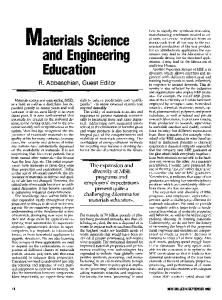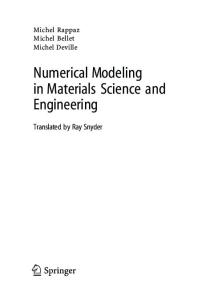The Use of Web-based Virtual X-Ray Diffraction Laboratory for Teaching Materials Science and Engineering
- PDF / 594,502 Bytes
- 6 Pages / 612 x 792 pts (letter) Page_size
- 53 Downloads / 332 Views
The Use of Web-based Virtual X-Ray Diffraction Laboratory for Teaching Materials Science and Engineering Yakov E. Cherner1, Maija M. Kuklja2, Michael J. Cima3, Alexander I. Rusakov4, Alexander S. Sigov5, Charles Settens3, 1 ATeL - Advanced Tools for e-Learning, 87 Stanley Rd, Swampscott, MA 01907, U.S.A. 2 Materials Science and Engineering Department, University of Maryland, 4418 Stadium Dr., College Park, MD 20740, U.S.A. 3 Department of Materials Science and Engineering, Massachusetts Institute of Technology, 77 Massachusetts Ave., Cambridge, MA 02139, U.S.A. 4 Yaroslavl State University, 14 Sovetskaya St., Yaroslavl', 150003, Russia 5 Moscow Technological University (MIREA), 78 Vernadsky Ave., Moscow, 119454, Russia ABSTRACT A virtual X-Ray Laboratory for Materials Science and Engineering has been developed and used as a flexible and powerful tool to help undergraduate and graduate students become familiar with the design and operation of the X-ray equipment in visual and interactive ways in order to learn fundamental principles underlying X-ray analytical methods. The virtual equipment and lab assignments have been used for: (i) authentic online experimentation, (ii) homework and control assignments with traditional and blended courses, (iii) preparing students for hands-on work in physical X-ray labs, (iv) lecture demonstrations, and (v) performance-based assessment of students’ ability to apply gained theoretical knowledge for operating actual equipment and solving practical problems. Students have also used the virtual diffractometer linked and synchronized with an actual powder diffractometer for blended experimentation. Using the associated learning and content management system (LCMS) and authoring tools, instructors kept track of students’ performance and designed new virtual experiments and more personalized learning assignments for students. The lab has also been integrated with the MITx course available on the massive open online course edX platform for Massachusetts Institute of Technology for undergraduate students. INTRODUCTION Today’s advanced research equipment is typically fully computerized with most tasks executed routinely without user participation. Procedures such as equipment calibration, data collection, data handling and interpretation are performed automatically. While this provides enormous benefits for researchers, it also creates a number of substantial educational drawbacks and limitations. Except sample preparation and installation, all procedures related to pattern analysis, measurements, peak indexing, etc. are executed by a computer without student involvement. This is one of the reasons why many students experience difficulties in assessing applicability and limitations of methods, and factors affecting data accuracy. Hence, they cannot correctly estimate the reliability of the results. In addition, many students, especially those enrolled in on-line or large-class science and engineering courses, lack opportunities for hands-on practice and experimentation that involve X-ray eq
Data Loading...











